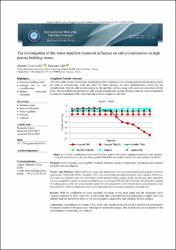The investigation of the water repellent chemical influence on salt crystallization in high porous building stones
Özet
Doğal taşlarda meydana gelen tahribatların en önemli sebeplerinden birisi sudur. Suyun tahribat etkisinden
sonra en fazla ayrışma, tuz kristalleşmesi yoluyla gerçekleşmektedir. Çözünebilir tuzlar, sularla beraber
kılcal boşluklara taşınır ve kristalleşir. Tuz kristalleşmesinin önlenemediği durumlarda kimyasal maddelerle
yüzey koruma uygulaması yapılmaktadır. Doğal yapı taşlarına, çevresel etkilere karşı dayanımlarının
belirlenmesi amacıyla laboratuvar ortamında değişik hızlandırılmış yaşlandırma deneyleri yapılmaktadır. Bu
çalışmada sodyum sülfat ve sodyum klorür çözeltileriyle tuz kristalleştirmesi deneyleri yapılarak, test edilen
tüf ve andezit örneklerinin tuzlara karşı gösterdikleri direnç incelenmiştir. 15 periyot tuz kristalleştirme
deneyleri sonrasında, su itici kimyasal madde sürülen ve sürülmeyen örneklerin ultrases dalga hızı, tek
eksenli basınç dayanımları ve ağırlık değişimleri incelenmiştir. Su itici kimyasalların uygulanması ile
ultrases dalga hızlarının yaklaşık %60’ın üzerinde arttığı bulunmuştur. Su itici kimyasal sürülen örneklerin,
kimyasal sürülmeyen örneklere göre tuz kristalleşmesinin yıkıcı etkisinden daha az etkilendikleri tespit
edilmiştir. One of the main factors which cause the decaying of the structures is the existent water in natural stones
which are used in constructions. After the effect of water damage, the most decomposition occurs by salt
crystallization. Soluble salts are transported to the capillary cavities along with water and crystallize. In
situations where salt crystallization cannot be prevented, surface treatment with chemical substances is
applied. Different accelerated aging tests are carried out in the laboratory to determine the resistance against
natural building stones and environmental effects. In this study, salt crystallization experiments with sodium
sulphate and sodium chloride solutions were conducted to examine the resistance of the tested tuff and
andesite samples to the salts. Ultrasonic wave velocity, uniaxial compressive strengths and weight changes
of the water-repellent chemical untreated and treated samples were investigated after 15 period salt
crystallization experiments. With the application of water repellent chemicals, it has been found that the
ultrasound wave velocities increase by more than 60%. It was found that water-repellent chemical-treated
samples were less affected than the destructive effect of salt crystallization compared to non-chemical-treated samples.
Kaynak
Journal of the Faculty of Engineering and Architecture of Gazi UniversityCilt
34Sayı
1Bağlantı
https://dergipark.org.tr/tr/download/article-file/680144https://www.doi.org/10.17341/gazimmfd.416513
https://hdl.handle.net/11630/7835
Koleksiyonlar
- Makaleler [69]
- WoS İndeksli Yayınlar Koleksiyonu [92]



















